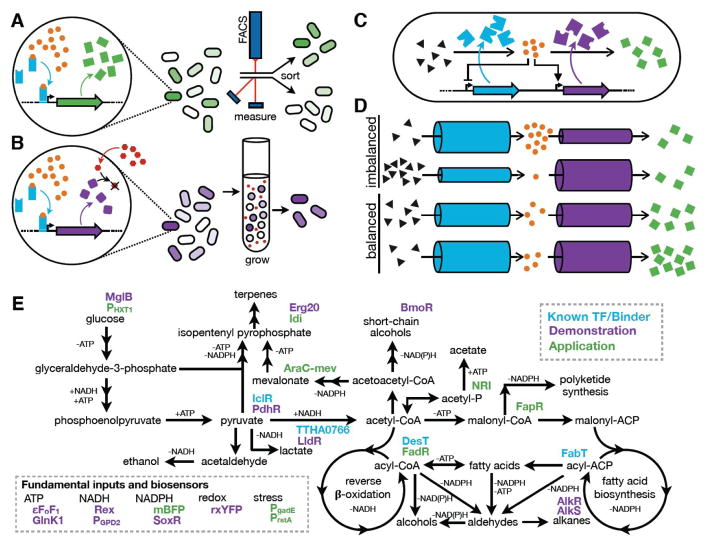Figure 3.
Applications of biosensors.
(a) A biosensor with an output, such as fluorescence, can be used in a screen. The metabolite of interest (MOI, orange) is detected by a biosensor, which drives the expression of an output signal (green) in proportion to the MOI concentration. The output signal, often fluorescence, is used to isolate high-producing variants through screening (e.g. FACS or plate reader assays). (b) A biosensor with a selectable output. The MOI drives the expression of a protein (purple) that provides a growth advantage to the cell. As depicted, an enzyme that neutralizes an antibiotic (red) is expressed in a ligand-dependent manner. Growing variants under selective pressure (e.g. in the presence of antibiotic) enriches the population with high-producing variants. (c) Biosensors for dynamic regulation of pathways. The MOI (orange) is detected by a biosensor (not depicted – biosensor actions are represented by feedback symbols) which alters expression of enzymes in the MOI pathway. The cartoon illustrates balancing of a pathway intermediate (MOI, orange) by repressing the preceding enzyme and activating the subsequent enzyme in the pathway (similar to [31]). (d) Visualization of pathway balancing. Enzyme activity is represented by tubes (i.e. maximal flux that can be carried). Regulation of enzyme concentration (by TFs or degradation) or activity (allostery) alters the flux capacity between pathway intermediates. When enzyme flux is imbalanced (top two examples), starting materials or intermediates accumulate and product formation is limited. When flux is balanced (bottom two examples), accumulation does not occur at any step. (e) Potential biofuel pathways and biosensors. Binding proteins and transcription factors (or regulated promoters) are shown with colors designating: known binder with no biosensor use published; demonstrated use as a biosensor; or biosensor applied to screening, selection, or pathway-balancing. AlkR [61]; AlkS [62] AraC-mev [63]; BmoR [24]; DesT [64]; εFoF1 [65]; Erg20 [27]; FabT [64]; FadR [30]; FapR [31]; GlnK1 [14]; Idi [27]; IclR (ecocyc.org); LldR [66], mBFP [16••]; MglB [67]; NRI [28]; PdhR [68]; PgadE [69]; PGPD2 [70]; PHXT1 [71]; PrstA [69]; Rex [15]; rxYFP [72]; SoxR [44]; TTHA0766 [73].

